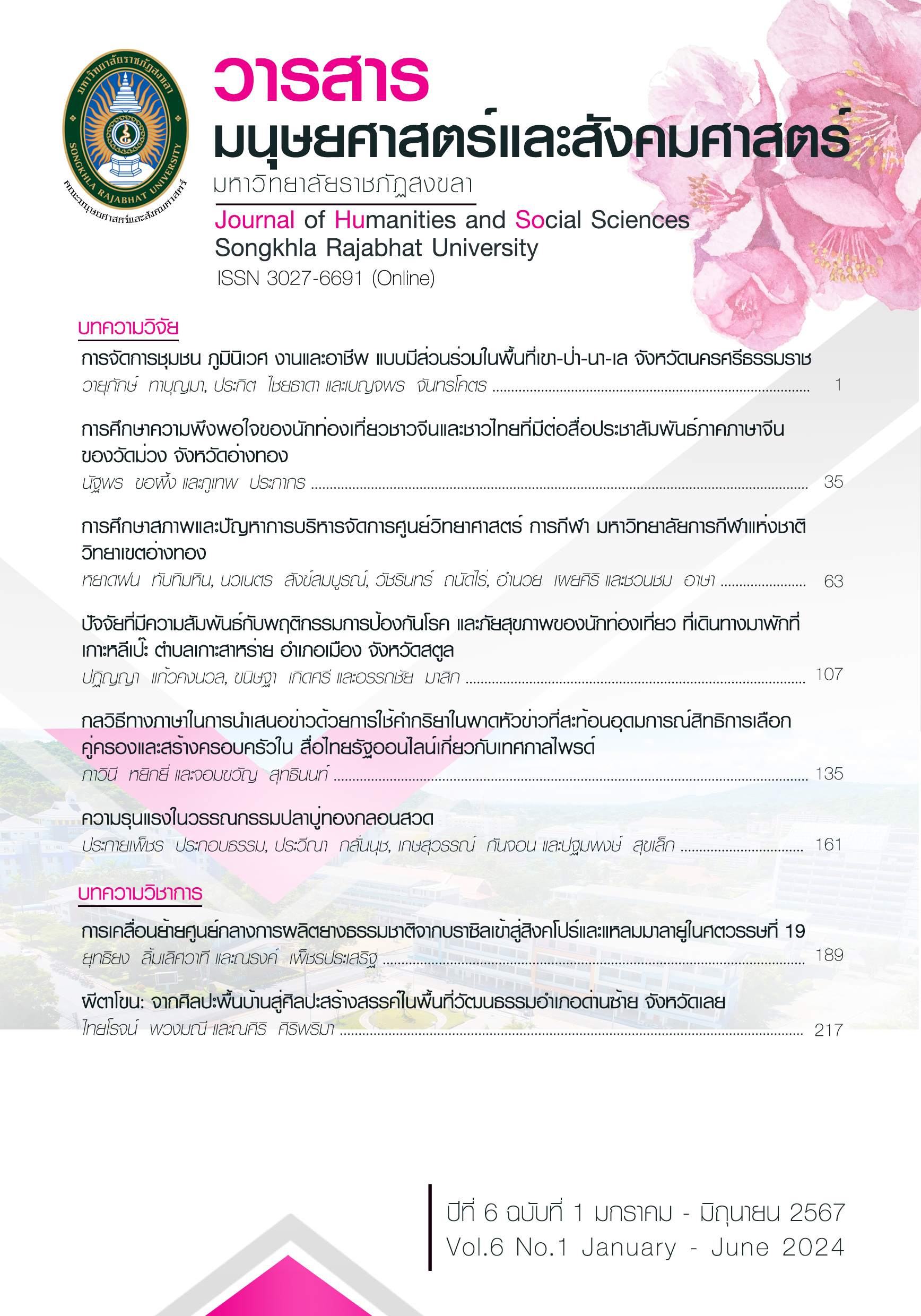THE RELOCATION OF THE NATURAL RUBBER PRODUCTION CENTER FROM BRAZIL INTO SINGAPORE AND THE MALAY PENINSULA DURING THE 19th CENTURY
Main Article Content
Abstract
This article examines the reasons for shifting the hub of natural rubber production center from Brazil, the region that supplied Europe and the United States with the most natural rubber during the late 19th century. Later, at the beginning of the 20th century, the rubber production center was moved to Southeast Asia. This is because of six key factors: 1) Developments and advancements in post-industrial technology in Europe have caused the emergence of the automotive industry. Therefore, it is vital to use natural rubber to produce wheels for cars; 2) Natural rubber from Brazil is a raw material that must be sourced completely from the Amazon rainforest, making its supply unpredictable; 3) The automobile industry boom in Europe and the United States requires a large and sufficient supply of raw materials to meet the needs of the industrial manufacturing lines; 4) The rubber-growing environments in Brazil and Southeast Asia are located along the equatorial belt, which is appropriate for rubber growth; 5) The cost of producing and harvesting rubber from nature is higher than that of Southeast Asia; 6) In Southeast Asia, rubber tree plantations are typically staffed with inexpensive Chinese workers. This made English traders and businessmen see profitable opportunities; therefore, rubber timber was planted during Straits Settlements in Southeast Asia at the end of the 19th century. The rubber plantation industry grew during the early 20th century. South East Asia has become the world's largest producer of natural rubber raw materials, replacing Brazil as a natural rubber hub. In this study, this article applies the historical approach to study and analyze information from research and Literature Review.
Downloads
Article Details

This work is licensed under a Creative Commons Attribution-NonCommercial-NoDerivatives 4.0 International License.
ลิขสิทธิ
References
กรมส่งเสริมการค้าระหว่างประเทศ. (2565). สถานการณ์ยางพารา และผลิตภัณฑ์ยางพาราของจีนปี 2021. สืบค้นเมื่อ 11 สิงหาคม 2566, จาก https://xn-42ca1c5gh2k.com/wp-content/uploads/2022/03/767367.pdf
การยางแห่งประเทศไทย กระทรวงเกษตรและสหกรณ์. (2560). ยุทธศาสตร์ยางพาราระยะ 20 ปี. สืบค้นเมื่อ 2 พฤษภาคม 2565, https://km.raot.co.th/uploads/dip/userfiles/
ชัยวัช โชวเจริญสุข. (2565). แนวโน้มธุรกิจ/อุตสาหกรรมปี 2565-2567 : อุตสาหกรรมยางพารา. สืบค้นเมื่อ 2 พฤษภาคม 2565 จาก https://www.krungsri.com/th/research/industry/industry-outlook/agriculture/rubber/io/rubber-2022
ณรงค์ เพ็ชรประเสริฐ. (2548). ก้าวย่างสู่ศูนย์กลางยางพาราโลก. กรุงเทพฯ: สำนักงานกองทุนสงเคราะห์การทำสวนยาง.
ปก แก้วกาญจน์. (2534). รายงานการวิจัยการสร้างทางรถไฟสายใต้กับผลกระทบทางเศรษฐกิจและการเมือง. กรุงเทพฯ: สถาบันทักษิณศึกษา มหาวิทยาลัยศรีนครินทรวิโรฒ.
ภูวดล ทรงประเสริฐ. (2535). ทุนสิงคโปร์การผูกขาดตลาดยางพาราและดีบุกไทย. กรุงเทพฯ: สถาบันเอเซียศึกษา จุฬาลงกรณ์มหาวิทยาลัย.
ภูวดล ทรงประเสริฐ. (2546). ทุนจีนปักษ์ใต้ : ภูมิหลังเบื้องลึกทุนใหญ่โพ้นทะเล. กรุงเทพฯ: ทิปปิ้ง พอยท์.
ลอเรนซ์ เบอร์กรีน. (2557). โคลัมบัสและเรื่องราวของการค้นพบโลกใหม่. กรุงเทพฯ: ยิปซี กรุ๊ป.
สกินเนอร์, จี. ดับเบิลยู. (2564). สังคมจีนในประเทศไทย ประวัติศาสตร์เชิงสังเคราะห์ [Chinese Society in Thailand an Analytical History] ใน ชาญวิทย์ เกษตรศิริ (บ.ก.). (พรรณี ฉัตรพลรักษ์, ชื่นจิตต์ อำไพพรรณ, ม.ร.ว., ประกายทอง สิริสุข, ภรณี กาญจนัษฐิติ, ปรียา บุญญะศิริ, ศรีสุข ทวิชาประสิทธิ, ผู้แปล). กรุงเทพฯ: สำนักพิมพ์มติชน. (2564)
สำนักงานเศรษฐกิจการเกษตร. (2565). ยางพารา. สืบค้นเมื่อ 11 สิงหาคม 2566, จาก https://mis-app.oae.go.th/product/ยางพารา
สำนักงานส่งเสริมการค้าในต่างประเทศ ณ กรุงสิงคโปร์. (2564). สิงคโปร์ : ศูนย์กลางการค้ายางพาราโลก. สืบค้นเมื่อวันที่ 3 พฤษภาคม 2566, จาก https://oldweb.ditp.go.th/contents_attach/732962/732962.pdf
Bonny, T. (2004). Tan Kah Kee. Retrieved May 6, 2023, from https://eresources.nlb.gov.sg/infopedia/articles/SIP_839_2004-12-28.html.
Davis, W. (1996). A Brief History of Rubber. Retrieved April 12, 2023, from https://rainforests.mongabay.com/10rubber.htm
Drabble, J. H. (1972). Investment in the Rubber Industry in Malaya C. 1900-1922. Retrieved May 2, 2023, from https://www.jstor.org/stable/20069988
Frank, Z. (2008). The International Natural Rubber Market, 1870-1930. Retrieved May 1, 2023, from https://eh.net/encyclopedia/the-international-natural-rubber-market-1870-1930/
History.com. (2018). Automobile HistoryRetrieved May 1, 2023, from https://www.history.com/topics/inventions/automobiles
Lee Kong Chian School of Business. (2015). About Lee Kong Chian. Retrieved May 2, 2023, from https://business.smu.edu.sg/landmarkgift/lee_kong_chian
Loadman, J. (2003). Sir Henry Alexander Wickham. Retrieved May 5, 2023, from http://www.bouncing-balls.com/timeline/people/
nr_wickham1.htm
Malaysian Rubber Producer's Research Association. (1995). The Exploitation of Natural Rubber. Retrieved August 14, 2023, from https://holdenslatex.com/content/pdf/history.pdf
Michigan Economic Development Corporation. (2016). The Automotive Hall of Fame. Retrieved May 5, 2023, from https://www.automotivehalloffame.org/honoree/bertha-benz/
Singapore Botanic Gardens. (2023). 1888: Ridley and the Malayan Rubber Industry (from 1896). Retrieved April 20, 2023, from https://www.nparks.gov.sg/sbg/about/our-history/1888-ridley-and-the-malayan-rubber-industry-from-1896
Sutherland, D. (2009). Tan Chay Yan. Retrieved May 4, 2023, from https://eresources.nlb.gov.sg/infopedia/articles/SIP_1628_2009-12-31.html
Wikipedia. (2023). Vulcanization. Retrieved May 4, 2023, from https://en.wikipedia.org/wiki/Vulcanization


